Roy Christopher's Blog, page 16
October 22, 2021
Boogie Down Predictions: Hip-Hop, Time, and Afrofuturism
October 13, 2021
Sleeper Effects: Aiming Your Appetite
October 7, 2021
Shatterday: The Quantum Creativity of James Ward Byrkit
October 3, 2021
The Medium Picture Object Thing: A Photo Essay
September 16, 2021
O Bother, Why Art Thou? Follow for Now, Vol. 2
Quick note: My new interview anthology, Follow for Now, Vol. 2: More Interviews with Friends and Heroes, is now available from punctum books! More details and table of contents below.
Read on!
O Bother, Why Art Thou?In the late aughts, I did a talk at several events and on several college campuses called “How to Do Stuff and Be Happy.” The title was a joke, but the advice was real. It was a bunch of things I’d learned in the pursuit of various interests, mostly writing and publishing. Someone asked me recently why I bother to do I do any of the things I do. What follows emerged from an attempt to answer that question.
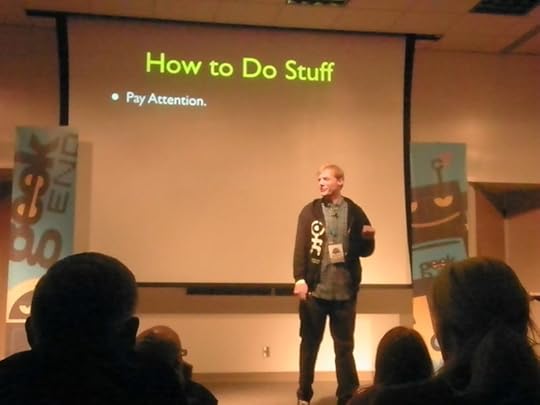
[“How to Do Stuff and Be Happy” at Geekend 2010. Photo by Patrick Rodgers.]
I started making zines in my teens. My friend Matt Bailie and I saw the first zine-review article in Freestylin’ Magazine and decided we should make one ourselves. It was the spring of 1986. We were just about to start high school.
Ten years later I registered the domain name of the last long-running zine I’d been making, and frontwheeldrive.com became my first website. After a false start or two, I ran the site steadily from 1999 to 2008. Two other like-minded dudes, Tom Georgoulias and Brandon Pierce, and I did interviews and wrote reviews about media and science and culture and whatever. Somewhere in there, I self-published the best of those interviews as a book called Follow for Now: Interviews with Friends and Heroes (Well-Red Bear, 2007).
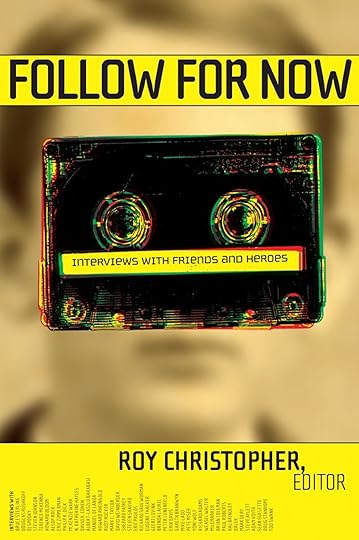
One wrongheaded move I made during my transition from skateboarding and music zines to heavy, heady websites was thinking that I needed to completely replace old interests with new ones. I had just become a reader of books and was wishing I’d been one all along, so it was out with the hip-hop and punk rock and skateboarding and in with the science and literature and media theory. Eventually I realized that if not for the one there wouldn’t be the other. Music taught me how to do research. Who was on what record label, who used to be in what band with whom, who produced what, who was down with whom—these were the footnotes. I was already digging for sources, for citations. Skateboarding introduced me to art and determination and all of the music I love. Everything is research, and there’s room for all of it.
For the decade after closing frontwheeldrive.com, I reluctantly moved everything over to a blog format under my own name, roychristopher.com. One of the things I had finally realized about strictly publishing interviews with other people is that the other people are the focus. That’s exactly how that should be, but if you’re trying to build your name as a writer, as I was, the interview format doesn’t showcase your writing. Blogging, for what it’s worth, does that. It’s you and your words, and that’s it.

I learned another minor lesson from simply the naming of a thing: As flimsy a front as it might be, if you run a publication, people will quote it—assuming you’re giving them words worth quoting. They will proudly print, “she told Roy Christopher of frontwheeldrive.com…” If you’re nobody like me, they won’t quote you if the website bears your name. They won’t proudly print, “she told Roy Christopher of roychristopher.com…”: a small lesson, but a lesson nonetheless.
Through two decades of doing these two websites, as well as all the zine and magazine work that preceded them, I suppose I have managed to establish myself enough to be able to pitch ideas, write books, and do freelance writing here and there. One thing that differentiates my writing from some of my colleagues and peers is that I don’t rely on it for my living. The truth is that, aside from a few years in the 1990s, I’ve just never been able to pay my bills as a writer. Hell, since then being a writer has cost me money! That’s not a complaint, nor is it important.
What’s important is that whether or not you rely on something to pay your bills changes the goals and the results of that something. For instance, I was interviewing a band last week. There is nothing unique about my interviewing a band. I’ve been doing it for a while. The difference is that if I’m interviewing a band, it’s because I like them. I’m interested beyond the story I’m writing. That makes the way I do interviews different from when I was doing them on assignment for money. It changes them so much that the bands I interview usually notice the difference.
I hope the same can be said for my writing in general. Dan Hancox at The Guardian (see?) described my recent book, Dead Precedents, as “written with the passion of a zine-publishing fan and the acuity of an academic.” That’s the kind of compliment you hope for, and it comes from pursuing a certain kind of goal. One of the things I have found when teaching writing to others is that students have the most difficulty coming up with something to write about. More than any other part of the writing process, topic selection stumps them—more than the challenge of the initial blank page, or coming up with titles, thesis statements, headlines, leads, or anything else. I tell them to find something they already like, that they want to know more about, and that they want to tell people about.
That impulse, that desire to tell others about something cool, is the core reason I do just about everything I do. It’s the reason I’m a writer. It’s the reason I’m a teacher. It’s the reason I made zines. It’s the reason I made websites. It’s the reason I’m writing this right now. No one can tell you “How to Do Stuff and Be Happy,” but when you find that thing, that impulse, that thing you’ll do anyway, you’ll be on your way.
Follow for Now, Vol. 2: More Interviews with Friends and Heroes
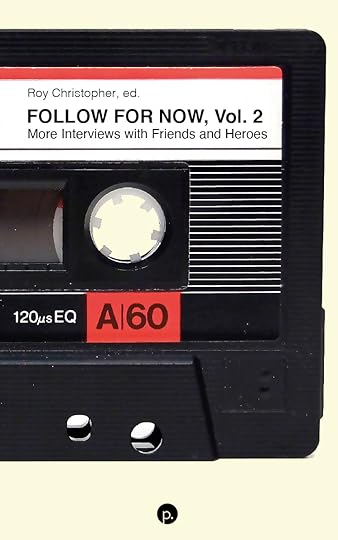
The above essay serves as the preface to a my new interview anthology, Follow for Now, Vol. 2. This collection picks up and pushes beyond the first volume with a more diverse set of interviewees and interviews. The intent of the first collection was to bring together voices from across disciplines, to cross-pollinate ideas. At the time, social media wasn’t crisscrossing all of the lines and categories held a bit more sway. Volume 2 aims not only to pick up where Follow for Now left off but also to tighten its approach with deeper subjects and more timely interviews. This one is a bit more focused and goes a bit deeper than the last. It includes several firsts, a few lasts, and is fully illustrated with portraits of every interviewee.
“Relentlessly stimulating and insight-packed, Follow for Now is the kind of book I’d like to see published every decade, and devoured every subsequent decade, from now until the end of humanity.” — Maria Popova, Brain Pickings
Here’s the full Table of Contents:
MEDIA:
Carla Nappi: Historical Friction
Kristen Gallerneaux: Unattended Consequences
Dominic Pettman: Human Matters
Rita Raley: Tactical Humanities
Jodi Dean: Of Crowds and Collectives (by Alfie Bown)
Gareth Branwyn: Borg Like Me
Ian Bogost: Worthwhile Dilemmas
Mark Dery: Nothing’s Shocking
Brian Eno: Strange Overtones (by Steven Johnson)
Zizi Papacharissi: A Networked Self
Douglas Rushkoff: The User’s Dilemma
danah boyd: Privacy = Context + Control
Dave Allen: Every Force Evolves a Form
HIP-HOP:
Juice Aleem: Don’t Be Afraid of the Dark
Labtekwon: Margin Walker
M. Sayyid: The Other Side
Shabazz Palaces: A New Refutation
dälek: Build and Destroy
Matthew Shipp: Heavy Meta
Tyler, The Creator: The Odd Future is Now (by Timothy Baker)
Tricia Rose: Warrior Soul
Sean Price: Bless the M.I.C.
Rammellzee: The Wrath of the Math (by Chuck Galli)
Cadence Weapon: Check the Technique
El-P: Wake Up. Time to Die.
Sadat X: My Protocol is Know-It-All
WRITING:
Ytasha L. Womack: Dance to the Future
Bob Stephenson: Bit by Bit
Pat Cadigan: Eyes on the Skies
Mish Barber-Way: Flour Power
Chris Kraus: Wildly Contradictory
Simon Critchley: The Skull Beneath the Skin (by Alfie Bown)
Clay Tarver: Gone Glimmering
Nick Harkaway: A Dynastic Succession of Trouble
Simon Reynolds: Erase and Start It Again (with Alex Burns)
Malcolm Gladwell: Epidemic Proportions
William Gibson: The Co-Evolution of Humans and Machines (by Kodwo Eshun)
Thirty-seven interviews deep, Follow for Now, Vol. 2 is a hefty collection of ideas and inspiration from some of the most important writers, artists, and thinkers of our time. It includes the first interview with Tyler, The Creator and one of the last with Rammellzee. A lengthy discussion between William Gibson and Kodwo Eshun caps it all off.
It’s now available from punctum books! Get yourself a pretty paperback or an open-access .pdf!
Thank you all for reading,
-royc.
September 10, 2021
August & September
With two new books out there (see below) and a few more in various stages of the publishing process, I've been feeling buried, writing and editing different things every day. In the meantime, I found a few fun things I wanted to share.
First, my friend and collaborator Tim Saccenti sent me these pictures the other night. The first is Dead Precedents with the hands from the cover of Run the Jewels' third album, RTJ3, which Tim shot.
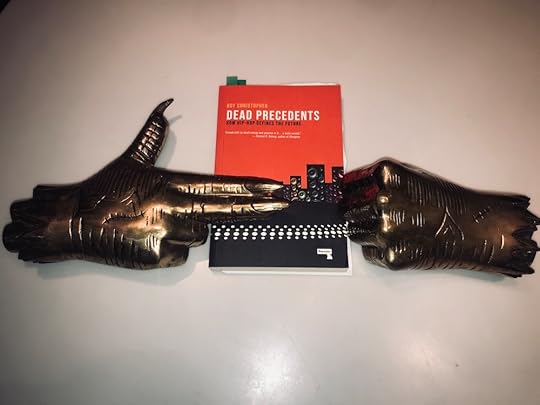
The second is Follow for Now with the hands from the cover of RTJ4.
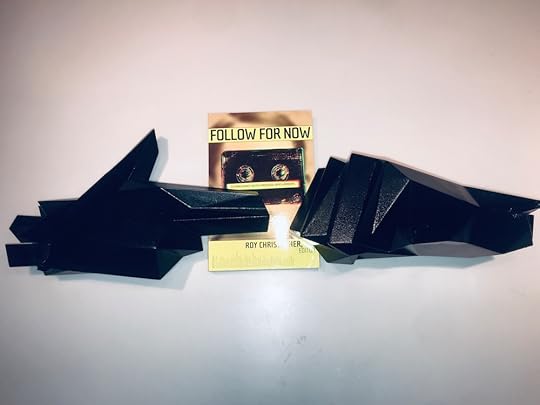
Tim and them made these! They are physical objects. Here's the story behind the hands straight from Tim and El-P on The Verge. I am honored to have my work even tangentially related to theirs.
Tim is a visionary photographer, videographer, and designer, and I've been fortunate enough to use some of his work in Dead Precedents and the forthcoming collection, Boogie Down Predictions: Hip-Hop, Time, and Afrofuturism. More on the latter soon.
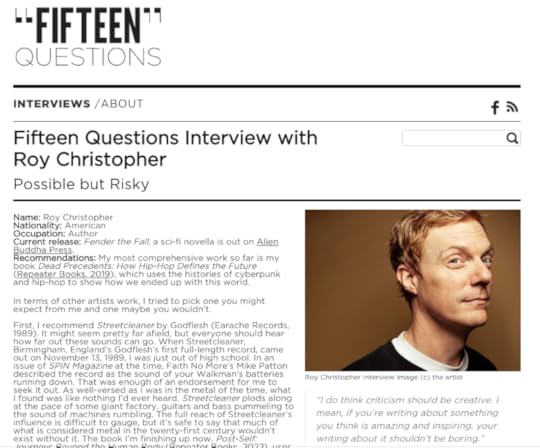
I did a fairly lengthy interview with Fifteen Questions this week. Here’s an excerpt:
There are many descriptions of the ideal state of mind for being creative. What is it like for you? What supports this ideal state of mind and what are distractions? Are there strategies to enter into this state more easily?
It probably sounds corny but feeling positive, like the work is worthwhile. There’s also that spark of inspiration that’s usually an exciting mix of both confidence and fear: the feeling that you’re fully capable of doing something mixed with the possibility that you might fail. It has to feel possible while also feeling risky.
Distractions abound. I suffer the same ones as anyone: social media, hunger, laundry. Turn off the ones you can, and deal with the rest as needed.
Doing the work every day is imperative. Sure, inspiration hits at odd and inopportune times, but working every day is the only way to get things done.
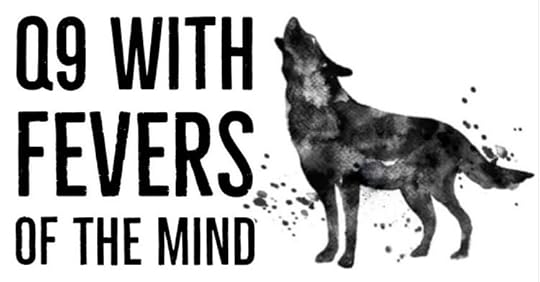
I also did a Fevers of the Mind “Quick 9” interview recently. Here’s an excerpt:
ICYMI:I never did well on writing assignments in school. In spite of my placement in advanced classes, I scored poorly throughout high school on writing-related projects. I made C’s in both English 101 and 102 in college, but in my second-to-last semester of undergrad, one of my instructors complimented my writing. We had done several in-class essays in her Abnormal Psychology class, and one day she pulled me aside and told me what a good writer I was. This came as a surprise, given my previous track record and the fact that I’d been an Art major for the first three years of college. Regardless, it stuck with me. I took a class on writing for social science research the next semester, and though I barely made a B, I felt more at home researching and writing than I ever had trying to do traditional art. I give the credit for my newfound confidence to my Abnormal Psychology teacher.
Many thanks to everyone who’s copped a copy of either of my new books. Both of these are steps in new directions in publishing for me, one into poetry and the other into fiction. Both have been scary and exciting. Your support means everything.
In case you missed them, here’s a bit about each:
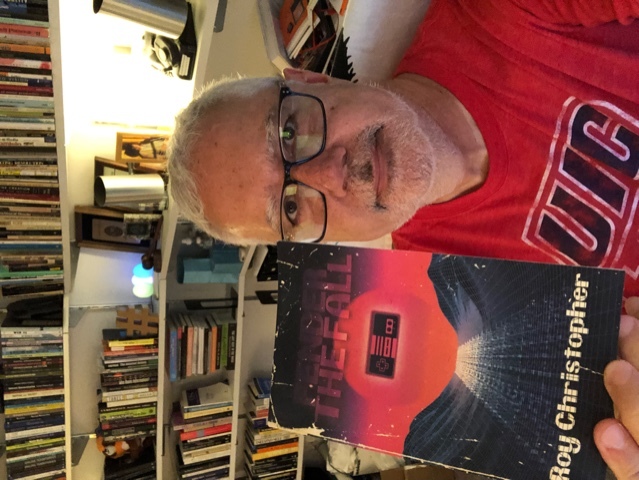
Professor Steve Jones of the University of Illinois-Chicago with his copy of Fender the Fall.
The poet Scott Cumming writes in his Goodreads review, “Short choppy chapters and sections coupled with an innovative design make for an original reading experience in what could be dubbed Back to the Future meets Primer, but funnier and less confusing than the latter.”
I put together a soundtrack for the book as I was writing it. There’s more about the book here and a look at the pages inside.
If you’re already sold, the paperback is here, but it’s also now available in a less-cool Kindle version.
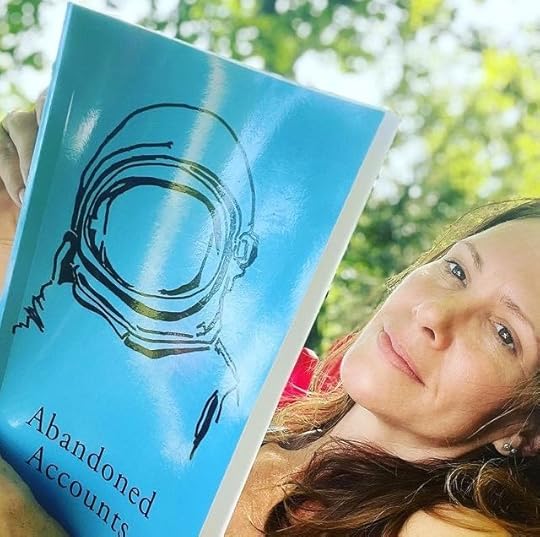
My friend Rachel Carter reading Abandoned Accounts.
My friend and fellow First Cut poet HLR wrote this nice review of Abandoned Accounts on her Treacle Heart website. Here’s an excerpt:
Roy Christopher is clearly comfortable with traditional forms and he bends these ‘rules’ to tell his story in the best way possible; the poems are terse and impactful in their simplicity, and Christopher has evidently mastered the art of rhyme. In some poems, the rhymes are watertight, building pace and maintaining rhythm, punching exactly where they ought to, and other poems have looser rhyme schemes, where Christopher plays freely with language and meter while still maintaining an utterly convincing voice. None of these verses are careless: every poem says exactly what it needs to, without relying on flowery language or incomprehensible metaphor or frivolous formatting or random risk-taking. Christopher is a true wordsmith, and as a reader, I was totally absorbed by his voice.
Many thanks to HLR for the kind words.
Can’t Stop, Won’t Stop:Coming up next are the interview anthology, Follow for Now, Vol. 2 from punctum books and the edited collection Boogie Down Predictions: Hip-Hop, Time, and Afrofuturism from Strange Attractor Press.
More on those soon!
Hope you’re well,
-royc.
September 6, 2021
The Roots We Share
One of my major struggles as a professor was always getting students to read. It's difficult to relate to the attitude since I became a reader myself, but I remember the resistance as an undergraduate. There were too many other things I wanted to be doing, and I didn't even have TikTok or Instagram to suck up the rare gaps in my days.
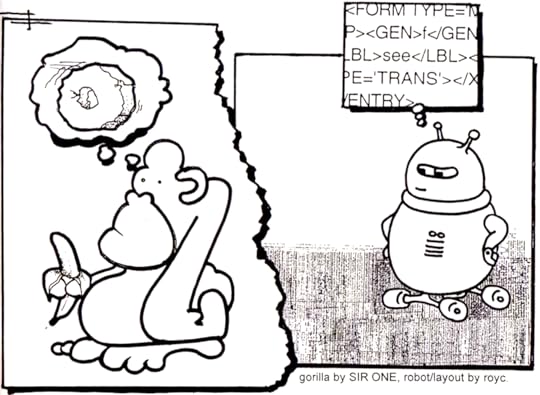
(A collaborative drawing from HEADTUBE zine by me and Sean Walling.)
When talking about our interactions with media, my friend Doug Rushkoff uses the remote control as a metaphor. The remote was the first invention that allowed interactive television viewing, and in the process, it changed the way we consumed the medium. Instead of wanting to see what's on, we want to see what else is on. The habit has carried over into every medium since. We scroll through our feeds not looking for something to read, but to make sure we don't need to read anything. This is how students approach reading for class. They don't set out a time to do the reading. They skim the material to make sure they don't need to read it. The only way to get them to read is to test them on the material. If I ask them to read something so we can discuss it in the next class meeting, a small fraction of them will. If I tell them to read something because I'm going to give them a quiz on it in the next class meeting, all of them but a small fraction will. The problem is that students don't like taking tests, and I never liked grading them. How do we get to the good stuff without all of these contrived assessments? We have to work together.
Another example: While legitimizing the downloading of music was one of the hurdles that Apple faced with record labels when introducing iTunes, another was the breaking up of the CD into individual songs. Record labels had long been making billions off of record, tape, and CD sales. Individual hit songs were mere marketing, advertisements for the CD. What Apple wanted to do legitimized downloading but broke down the price structure of the millennial record industry. Instead of buying 15-18 songs for $17.99, now listeners could buy just the song they wanted for $.99. It streamlined the process for listeners but cut out massive profits for the labels. Full-length records didn't go away completely, but now there are other options for music fans.
I remember reading some years ago that a successful direct-mail campaign, that is a physical mailing of postcards advertising some good or service, had a 2% response rate. That means that 98% of the materials and effort of a successful campaign were wasted. These mailings still exist, but email has revolutionized such campaigns. With such a reduced overhead, the response rate of a successful spam campaign must be infinitesimal.
Anyway, I've been thinking about these shifts in media consumption and the subsequent waste in the context of writing. Unlike records or CDs, which are clunky and inconvenient at best, books are an unimprovable technology, but now there are other options. There are blogs and tweets and newsletters and other media altogether. As readers and writers, we have so many more options. Reading and writing are collaborative. As readers, how do we cut out the crap and get to the good stuff? As writers, how do we streamline the process of reaching readers?
I have noticed more and more our unwillingness to meet each other halfway, to see things from another's point of view. Not just as readers and writers, but as humans sharing a ball of dirt in space. It’s an inability that borders on abject refusal. The example I always use is the one time I went to a personal trainer. I had a free consultation with my climbing-gym membership in Chicago, so I went. As the guy asked me questions and ran me through exercises, he slowly stopped listening to what I was saying and put me into one of his pre-planned regimens. He already knew what he thought I needed before he even weighed me in.
The same thing happens with coworkers, teachers, students, editors, employers, friends, everyone. We need to be more able to break out of our own views and see things from others. If not, we are doomed. It’s not just empathy. It's being able to completely drop your own agenda and understand someone else's views and goals. Communication is a collaboration. We have to work together.
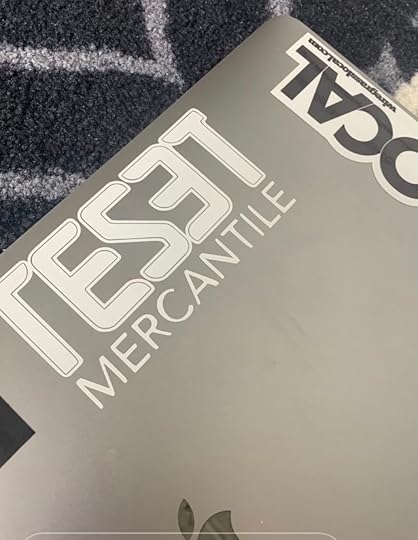
(RESET Mercantile logo sticker, as designed by me and Justin April.)
Collaboration is not compromise, it's a chance to make a connection. Cooperation is not a problem to solve, it's an opportunity to understand. Together we can make everything better, or as I plan to cross-stitch on a throw pillow:
The fruits we bear are made sweeter by the roots we share.Happy Labor Day! More news soon.
Hope you’re well,
-royc.
August 15, 2021
Fender the Fall
During a particularly dark period in my adult life, I decided I wanted to learn how to write screenplays. I’d gone through a horrible breakup, moved back home, and was working part-time at a chain record store. I was floundering around, unsure of what to do next.
One night I watched Richard Kelly’s Donnie Darko (2001) for the second time, but I saw it for the first. It struck something in me, in that time, and I wanted to figure out how to write a movie. I got the script and started studying what you put on the page to make things happen on the screen.
As a result, the screenplay I started writing was heavily influenced by Donnie Darko. I’ve worked on it off and on in the fifteen years since, and even took an introductory screenwriting class at Second City. Last year I finally novelized the whole thing into a loooong short story.
Fender the Fall is about Chris Bridges, a lovelorn physics graduate student who goes back in time to return the journal of his high-school crush in order to save his marriage and her life. The plan doesn’t go as planned.
Tagline: You don’t know what you’ve got until you get it back.
It’s now available from Alien Buddha Press! It’s 5”x8” and 136-pages long, like a good paperback should be. It’s the perfect fall read.
I was fortunate enough to get Matthew Revert to design the cover and Mike Corrao to do the typesetting. As a result, it’s a sharp-looking little book. Check it out:
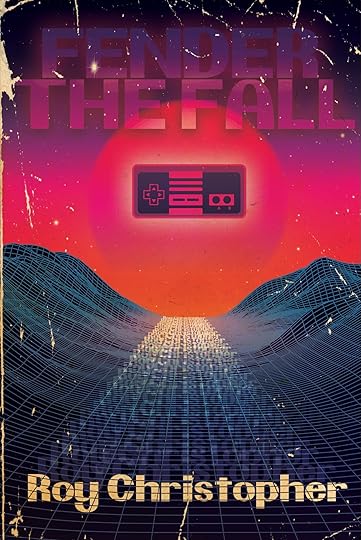
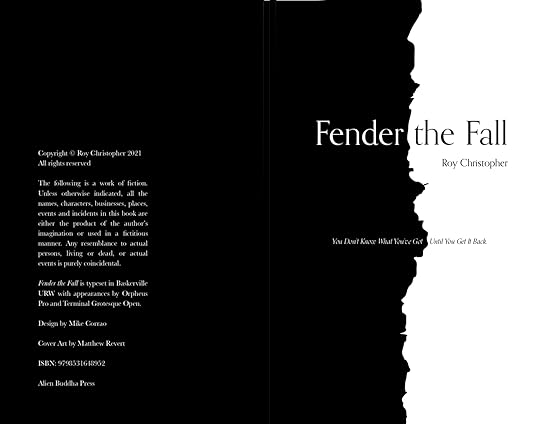
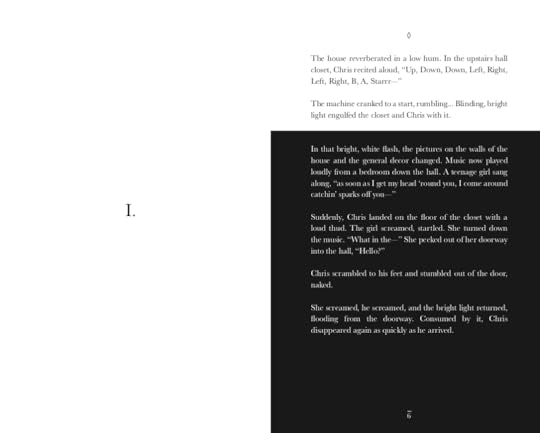
Here’s what other people are saying about it:
“A fun, classic roller-coaster of a time-travel story that could have been published in the 1950s, except that it’s furnished with all manner of savvy insights into current 2020s life.” — Paul Levinson, author of The Plot to Save Socrates
“Fender the Fall is a nostalgia-infused journey through time about second chances and the causality of love. It’s a formative song from your youth revisited, a favorite VHS tape found in the back of your closet.” – Joshua Chaplinsky, author of The Paradox Twins
“Hard-boiled strange loops in a froth of weird.” – Will Wiles, author of Plume
Many thanks to Matt Revert and Mike Corrao for making this thing look so good; Red Focks for putting it out there; Paul Levinson, Josh Chaplinsky, Will Wiles, Jaqi Furback, Gabriel Hart, C.W. Blackwell, Ira Rat, J. Matthew Youngmark, and Jeph Porter for their time, feedback, and kind words; and Claire Putney, from whom I stole the title.
Here’s a soundtrack I put together while writing Fender the Fall. It has songs mostly from and around the years in the story (2002 and 1991).
Order your copy of this lovely, little paperback from Alien Buddha Press now! You won’t regret it.
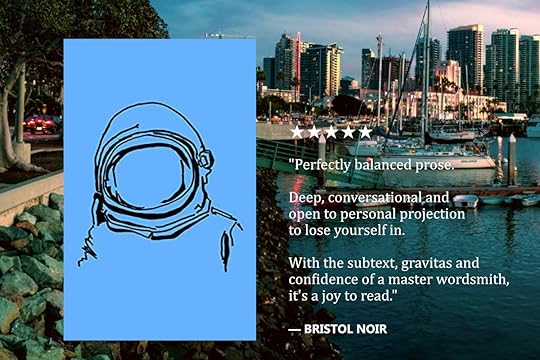
And don’t forget about my recent collection of poems, Abandoned Accounts, about which Bristol Noir says, “Perfectly balanced prose. With the subtext, gravitas, and confidence of a master wordsmith. A joy to read.”

One last thing: My next book for Repeater Books, Post-Self: Journeys Beyond the Human Body, comes out next March during SXSW. I’m hoping to go down there and talk about it. Voting is now open, so if you could go drop a quick vote for my talk, I would appreciate it.
Thank you!
Hope you’re well,
-royc.
July 30, 2021
Abandoned Accounts
I’ve been writing poetry since before I could write. I would shout them out in alliterative, repetitive, rhyming couplets, and my mom would take dictation. Once I started writing, I wrote poems, short stories, comic books, fake newspapers.
In high school, I took to making zines publicly and writing poems privately. Everyone I looked up to was a poet of some fashion. From the smart sense of Danny Elfman and David Byrne to the gothic verse of Robert Smith and Andrew Eldritch, from the street knowledge of Ice-T and KRS-One to the hardcore chants of Kevin Seconds and Ian MacKaye, poetry was the process, the worded frame for the world. So, I started writing my own again, stilted little stanzas of teen longing and angst, mostly designed to make me seem deep to my friends and interesting to girls.
Last spring, when the lockdown started, I found it difficult to focus on the larger projects I had in progress. In the months before, I’d started writing silly little poems about odd memories I had, tiny stories that didn’t fit anywhere else. I went back to those when I couldn’t think any larger. I eventually moved on to short stories and finally back to book-length writing, but not before I amassed a small collection of fitful misfit verse.

All of this is to say I have a poetry collection coming out today. Abandoned Accounts: Poems, 2020-2021 has those silly memories I started writing down, including reflections of walks in the woods at my parents’ house in the hinterlands of southeast Alabama, encounters with favorite bands and somewhat famous people, tales of travel and intrigue, and a few stray poems from as far back as 1990. It’s available in paperback and on the Kindle today!
Here’s a taste: the great Scott Cumming reading “Virga” from Abandoned Accounts:

It’s a fun little book of verse. Get a pretty blue paperback for $7.99 or the Kindle version for only $3.99!
Thank you!
More soon,
-royc.
July 4, 2021
BIG MESS: How Gene Simmons and Danny Elfman Made Me a Music Nerd
Gene Simmons might be one of the most polarizing personalities on the planet. He co-founded one of the most controversial bands of the 1970s, has allegedly had his way with thousands of women, has run magazines, written books, hosted talk and reality shows, and has revolutionized music marketing and merchandising. I’ve always had a soft spot for The God of Thunder, but I’m never surprised when I find someone who hates him. For better or worse, he’s one of the reasons I’m a music nerd.
In Edgar Wright’s 2017 movie Baby Driver, the main character, Baby (played by Ansel Elgort), is a music nerd himself. He has tinnitus from a car accident he suffered as a child. The accident also killed his parents, more importantly, his mother. She was a singer and instilled in the young Baby a love of music. Since acquiring the “hum in the drum,” he listens to music constantly. With various components of stereo equipment, he also makes his own: glitchy, analog collages made from recordings of conversations, various samples, and beats banged out on keyboards and other music machines. Never without his earbuds, Baby sings and plays along, mimicking the instruments on tables or steering wheels.

When discussing a song with her name, Debora (Lily James), Baby says the song is by “Trex.” Here is where Baby’s nerdom and mine diverge. As everyone knows, the band’s name is “T. Rex,” not “Trex,” but Baby’s mispronouncing of the name illustrates that he’s more interested in the music itself and not the bands or information surrounding them. The kind of nerd I am couldn’t tell you the key a song is in or how to play the first note, but we know the name of the band. Not only that, but we also know that the song “Debora” was recorded back before Marc Bolan had shortened his band’s name from Tyrannosaurus Rex to T. Rex and helped spread the glam through rock on a global scale.
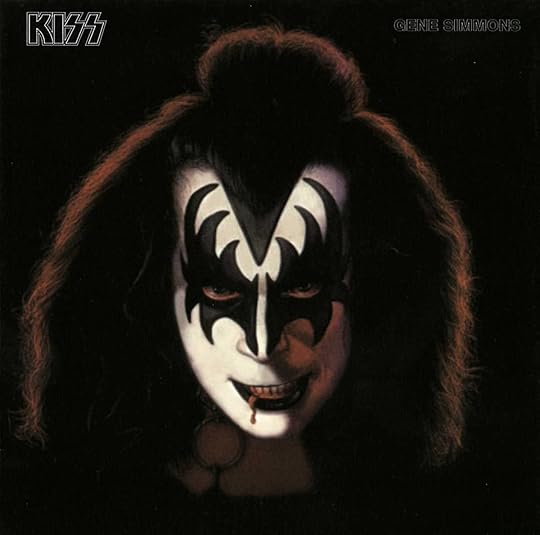
The first record I ever bought with my own money was Gene Simmons’ KISS solo record. In 1978, the four masked men each released solo records. Gene’s wasn’t the best corner of the square (Ace Frehley’s can easily claim to that spot), but it was probably a solid second, even if a distant one. Because of things like those solo records, KISS fans knew all the members, their roles, their alter egos. The Wu-Tang Clan notwithstanding, most bands aren’t promoted as collectives, and most of their members aren’t promoted as individuals. KISS was my first favorite band and Gene was my first favorite member.
This is back when a Journey album cover or a Rob Roskopp skateboard graphic would inspire a story that could occupy your mind for months. The wayward spacebug, once captured and then escaped. The monster breaking through the target just a little more on every board. I never own either a Journey record or a Rob Roskopp deck, but you’d see the images in the magazines or at the record store or skate shop, and your mind would wander. KISS is a band that invited investigation from its young fans. From their comic-book personae, superpowers, and devilish face paint to their catchy, cheesy songs, they had a lock on the imagination of preteen boys for over a decade. We had to dig deeper, and, thanks to a massive merchandising arm, there was always more to find: comic books, pinball machines, action figures, and the movie, KISS Meets the Phantom of the Park (1978), among other things.

In the second grade, I saw KISS live in Biloxi, Mississippi on what was to be their last tour in the makeup until the inevitable reunion tours. KISS remained my favorite band for the next few formative years. In middle school, my friend Keith Vanderberg introduced me to Oingo Boingo. Oingo Boingo was the first band whose lyrics actually made me think about things. Danny Elfman’s songwriting elevated my expectations. Bands like KISS were soon on their way out of my shoebox of cassettes, and bands like Talking Heads, The Police, and The Clash were in, eventually giving way to the hardcore of 7Seconds and Minor Threat, the hip-hop of Boogie Down Productions and Public Enemy, and the indie rock of Superchunk and the Grifters.
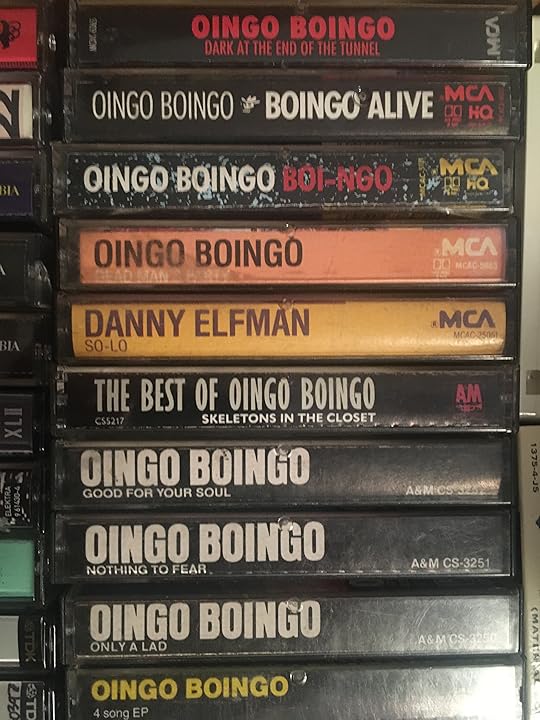
At my first staff meeting for Tacoma, Washington’s Pandemonium! Magazine in 1994, the guy next to me pitched a story on the new Oingo Boingo record. I leaned over and whispered to him that I didn’t realize they had a new record. He said he’d just gotten back from Elfman’s house: “Give me a ride home, and I’ll give you a copy.” That record ended up being Boingo, their last as a group. Once I’d moved on from Oingo Boingo, Elfman had as well. He has scored many movies you’ve seen. He’s worked with directors like Tim Burton and Gus Van Sant, an on movies from Pee Wee’s Big Adventure (1985) to The Woman in the Window (2021), as well as many in between like Beetlejuice (1988), Batman (1989), Good Will Hunting (1997), and The Circle (2017). He even composed the theme song for The Simpsons.
Gene reemerged sometime later, impressing me with his indie-rock knowledge. In some music magazine in the early 1990s, Gene talked at some length about the lineage of Teenage Fanclub, including BMX Bandits and his love of Eugenius. This seemed not only out-of-character for him, but also oddly too well researched not to be genuine. It was impressive.
Fast-forward a few more years, and I had moved up to editor of Pandemonium!. KISS had reunited for what would be the first of several top-grossing tours in the old makeup. In a fit of nostalgia, we were planning to put them on the cover of our Halloween issue. Our staffer Dave Liljengren was handling the interview, but when Gene called him to chat, Dave was on his way out the door to something he apparently could not miss.
Dave: “Sorry, Gene. I’m walking out the door. Can you call me back at the same time tomorrow?”
Gene: “Not a problem.”
Now, you’d think that this on-and-off freelance writer for this little regional rag in Tacoma, Washington had just blown his one chance for calling Dr. Love (that’s certainly what I thought), but I’ll be damned if Gene didn’t call Dave back the next day and do the interview as planned. We didn’t end up using it (Finding out before we went to press that the October 1996 issue was going to be our last, I put another of my all-time favorite bands on the cover: the mighty Godflesh), but the point is that Gene Simmons could be bothered to call back the next day.
So, say what you will about Gene Simmons. He is all of those things: a slimy, brilliant, shameless, hokey, flamboyant, cheesy, innovative, and a giant still casting his long shadow from my distant past.

Danny Elfman, on the other hand, just released a new record of punky prog-pop. Big Mess is as dark and weird as anything he ever did with Oingo Boingo, but tinged and tainted with the times. Imagine the rambunctious new wave of that band of misfits, combined with Elfman’s orchestral knowledge of decades of film scores, then compressed by recent politics and a year-long lockdown, and you’re almost there. He even redid the Oingo Boingo song, “Insects.”

Again, Elfman was the guy who taught me that music could be about something and introduced me to the music that would shape my mind as a teen. Now, music “about something” is typically the last thing I want to hear, but Big Mess has been on repeat in my house and in my head since it came out last month. The anger, the angst, the energy: decades on, he’s still got it.



